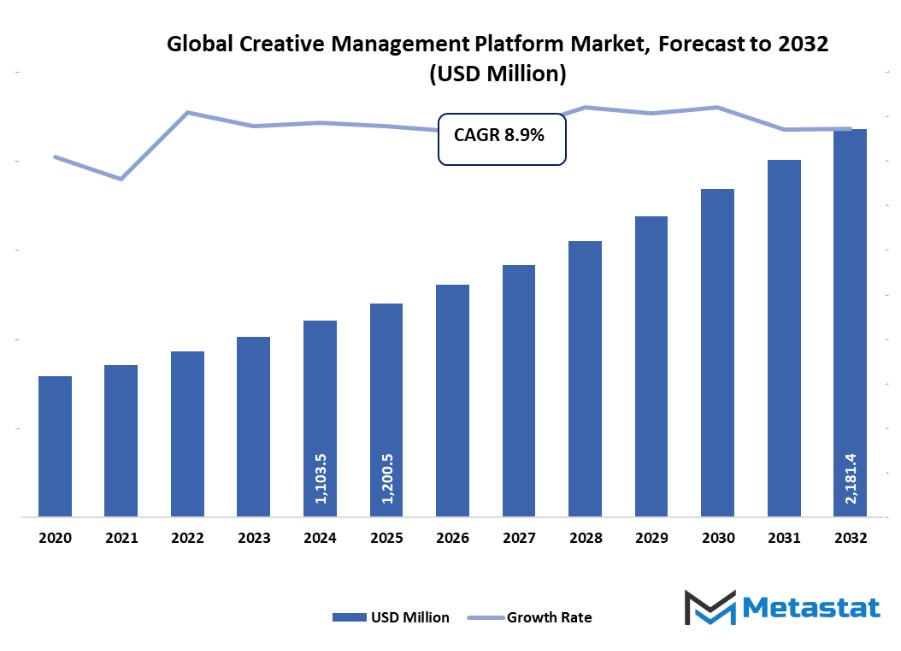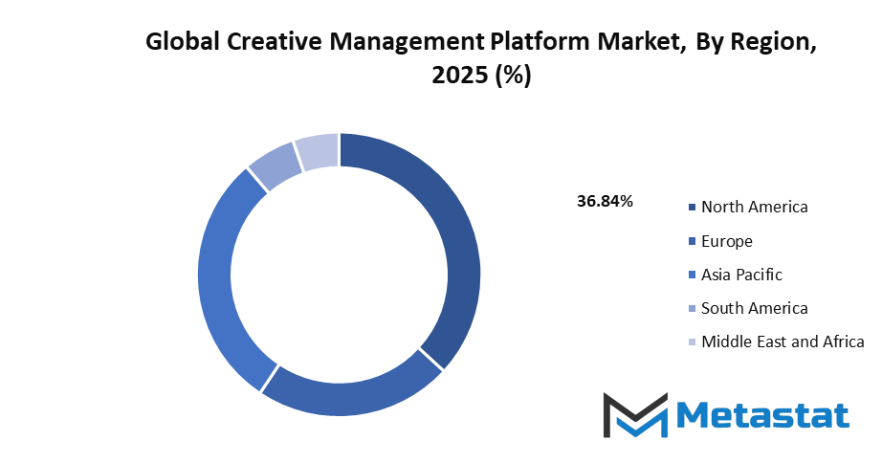Global Creative Management Platform Market - Comprehensive Data-Driven Market Analysis & Strategic Outlook
- Gobal creative management platform market valued at approximately USD 1200.5 million in 2025, growing at a CAGR of around 8.9% through 2032, with potential to exceed USD 2181.4 million.
- Advertisers & Agencies account for a market share of 36.6% in 2024, driving innovation and expanding applications through intense research.
- Key trends driving growth: Growing demand for personalized and dynamic advertising content, Rising adoption of digital marketing and programmatic advertising
- Opportunities include: AI-driven automation in ad design and targeting presents significant opportunities
- Key insight: The market is set to grow exponentially in value over the next decade, highlighting significant growth opportunities.

Market Background & Overview
The global creative management platform market will be one of the major segments of the digital marketing and advertising technology industry landscape that will emerge to focus on the automation, optimization, and on the managing of creative assets that are from multiple channels. Such a market would empower brands, agencies, and enterprises to visually design, produce and distribute content of high quality and of huge volume at the same time ensuring that the products are consistent with, efficient and strictly follow the brand guidelines. The marketing utilities will be the one stop shop for design tools, workflow automation, asset libraries, and collaborative features, allowing marketing teams to speed up the productivity of multiple campaigns across web, social media, email, and mobile platforms seamlessly.
The global creative management platform market is likely to solve the problem of how centralized creative operations can be more efficient and that creatives such as designers, marketers, and external partners be stakeholders who are allowed to work in synchronized environments. These platforms may be equipped with real-time feedback, version control, and analytics-driven insights, thus enabling organizations to assess creative performance and make good use of content for a variety of audiences. To make creative production more efficient, where less human input is involved, and to provide automatic recommendations and personalization depending on the customer behaviour and market trends, artificial intelligence and machine learning will be the technologies that are used.
One of the advantages of the global creative management platform market development is that it will grant to the users the ability to chain the campaign quickly without the usual administrative bottlenecks and creative who-duplications limiting their quality of work. The platforms will be able to organize the relations between the collaborators, and they will also make the difficult operation of a simple and will allow brands to maintain their strategies across different channels. They will do this by reinventing the market for contemporary content management and for strategic creative planning by using the power of the combination of automation, analytics, and design, thus providing organizations the ability to display and deliver brand experiences globally to their clients which are consistent, engaging and quantitative.
Market Segmentation Analysis
The global creative management platform market is mainly classified based on User, Enterprise Type, Industry.
By User is further segmented into:
- Advertisers & Agencies: Community engagement platforms will be employed by advertisers alongside advertising agencies to pull in the target audience, get consumer insights, and conduct interactive campaigns. Apart from the performance of campaigns being raised by these platforms, users will be able to engagement metrics, and thus, brand loyalty through the most recent feedback as well as content-driven interactions will be facilitated.
- Brands & Publishers: Communication platforms will be essential in allowing publishers and brands to not only lead the loyalty but also build communities, deliver customer experiences, and make the co-creation of content easier. Communication will become more personalized, audiences more precise and direct relationships with consumers will be established, which will facilitate marketing activities and attract stronger bonds with both loyal and potential consumers.
By Enterprise Type the market is divided into:
- SMEs: Community platforms will be the weapon of choice for small and medium-sized businesses (SMEs) to be heard, reach hard-to-reach audiences, and compete on an equal basis with big players. Cloud-based solutions that are inexpensive with managed services will enable SMEs to implement platforms without jeopardizing finances and concurrently enhance brand recognition and customer engagement.
- Large Enterprises: Engagement platforms will be the masts for the ship of big companies to navigate high-level internal and external communication and collaboration. Big companies will have the complete benefit of scalable solutions, enriched analytics, and AI-driven insights to tackle global communities, track engagement trends, and engage stakeholders across not just different countries but different departments as well.
By Industry the market is further divided into:
- Telecom: By utilizing platforms, telecom companies will be able to have better customer relations, provide quick solutions to service-related problems, and form communities made up of brand lovers. Platforms will become a part of the efforts of mobile network operators to reduce defection rates, launch loyalty schemes, and offer real-time support.
- Retail & E-commerce: Participation of customers by retailers in e-commerce platforms will be the key to the company to establish relationships with customers, motivate the collection of feedback, and create interactive shopping experiences. For example, tech will make it easy to release the latest products, to carry out sales and personalized campaigns that will increase the turnover you hope for.
- Gaming: Gaming would establish a direct connection with their audience using these platforms where they would suddenly announce brand new games and share all the details about the game while also ending with a call-to-action informing players on how to get involved. Platforms, further, supply such details as user behaviour to the gaming development and advertising teams.
- Travel & Tourism: Virality of the platform and increased interaction with travelers in the form of reviews, advice, and community-generated content will be the reasons why such travel and tourism businesses will sign up. This strategy ensures continuous quality improvement in the customer’s journey as well as exceptional organizing of tourist visits and the launch of loyalty plans.
- Entertainment: Interaction with consumers, fan base development, and content marketing via interactive forums will be the ways entertainment businesses implement community engagement strategies. Engagement will be driven by live hosting of interactive play and feedback solicitation and gaming content-based marketing campaigns.
- Others (Financial Services, Education): Besides the financial services and education sectors, other industries will also adopt platforms that enable direct communication with clients, students, and professionals. Furthermore, applications will make it possible for knowledge exchange, web-based support, training courses, and professional or customer communities to emerge.
|
Forecast Period |
2025-2032 |
|
Market Size in 2025 |
$1200.5 Million |
|
Market Size by 2032 |
$2181.4 Million |
|
Growth Rate from 2025 to 2032 |
8.9% |
|
Base Year |
2024 |
|
Regions Covered |
North America, Europe, Asia-Pacific, South America, Middle East & Africa |
By Region:
Regional differences will be substantial in the global creative management platform market as it traces to the varying adoption levels of digitalization, marketing sophistication, and technological infrastructure. The United States, Canada, and Mexico, which are all part of North America, will stay in front of the market through advanced marketing ecosystems, the wide deployment of digital advertising technologies, and the early adoption of the most innovative creative management solutions. Organizations in this area will do these things for the automation of processes, the optimization of cross-channel campaigns, and, most importantly, the keeping of brand messages consistent during global operations of high complexity.
The UK, Germany, France, Italy, and the rest of Europe, i.e., the continent, will be regions where the adoption will be quite impressive and brand standardization, regulation, and the proper handling of content will be the main driving factors. European enterprises and agencies will have to get used to the fact that they have to make creative management platforms their first choice if they want to be successful in the management of multilingual campaigns, the collaboration of in-house staff and the external agencies to be simplified, and the tracking of creative performance to be done with accuracy. As a result, these platforms will find themselves evolving into indispensable marketing strategy tools for different markets spread all over the continent.
The Asian market, and with that India, China, Japan, South Korea being the fastest developing market will have a significant impact on the rise of the global creative management platform market as the Asian Pacific region is predicted to be the place where the transition to a digital world will be made in the shortest time possible. The digitization of the economy of the region, the growing marketing spends, and the greater focus on omnichannel experiences will be the factors that will determine this market's growth. South America, trailed by Brazil and Argentina, and the Middle East & Africa, which consists of GCC nations, Egypt, and South Africa, will be regions where the adoption will be gradual, as companies will update their marketing processes and introduce cloud-based platforms to help in creative workflow. In every location, the global creative management platform market will provide organizations with the tools they need to unify content management, increase productivity, and implement data-driven creative campaigns that are consistent.

Market Dynamics
Growth Drivers:
- Growing demand for personalized and dynamic advertising content: One of the main factors for the global market of creative management platforms will be the need for personalized and dynamic advertising content. Brands and advertisers are shifting their focus toward delivering customized campaigns that would engage the target audience in a more efficient manner. The use of creative management platforms allows for the easy handling of the production, asset management, and distribution of visually attractive and relevant content, which in turn results in campaign effectiveness and audience response.
- Rising adoption of digital marketing and programmatic advertising: The rising use of digital marketing and programmatic advertising is another important reason for the market's expansion. Companies from different sectors are implementing digital channels to reach a larger audience, have a more direct contact, and obtain results that can be measured. The use of creative management platforms makes it possible to automate the creation of assets, management of campaigns, and tracking of results, showing that consistency can be maintained across different channels and that the time for campaigns to go to market can be shortened.
Restraints & Challenges:
- High subscription and integration costs for SMEs: High subscription as well as integration costs for SMEs are still the biggest factors limiting the development. Small and medium-sized enterprises may in a way find the creative management solutions for the advanced sector of the industry too expensive making them less at liberty to take up these platforms despite the potential benefits of productivity and engagement.
- Data privacy and compliance challenges in ad personalization: In addition, issues of data privacy and compliance are also hurdles to more widespread adoption. Platforms that handle personalized advertising content must be in line with the global data protection regulations such as GDPR and CCPA. Inaccuracies that might include data breach or the misuse of consumer information could pose to the willingness of organizations to fully take advantage of creative management platforms.
Opportunities:
- AI-driven automation in ad design and targeting presents significant opportunities: The use of AI in automation of the design and targeting of ads is just one of many opportunities presented. Using artificial intelligence, creative platforms can automatically generate creatives tailored to a specific audience, to include the optimization of content for a particular audience, and even to predict the engagement impact. With this capability, brands become very efficient thereby considerably reducing the human effort required and ensuring that high-performing campaigns are released at a regular cadence. Furthermore, harnessing AI analytics in conjunction with creative platforms represents a key to unlocking the innovative potential that marketers will be able to extend their campaign across the globe and reap more benefits.
Competitive Landscape & Strategic Insights
The global creative management platform market will look a lot like both big established companies with a global reach and new regional players with innovative ideas, the latter creating a tug-of-war but ultimately also a market with more flex, in other words: a creative market. Those in strong positions such as Celtra, Inc., Frontify AG, Smartly.io Solutions Oy., Adzymic Pte Ltd., Bynder, Marin Software Incorporated, AdCreative.ai, Bannerflow, Inspired Thinking Group (ITG) Limited, and Adobe, Inc. are the ones most likely to pave the way of this fascinating industry with their cutting-edge technology offerings, full platform capabilities, and global distribution networks. This type of companies will be targeting mainly the issue of offering scalable, customizable solutions that permit companies to control creative production, distribution, and metrics for a variety of channels in a cost-effective manner.
Newcomers will contribute in no small measure to strengthening the market by offering domain-specific products as well as by seeking specialized target groups and by shining a light on the elements such as AI-driven creative optimization, collaborative workflow, and real-time performance monitoring. The main gist of their business models will be strengthening the user's experience, lightening campaign management, and enabling fast creative content's iteration to keep up with omnichannel marketing's requirements going up.
The market will experience big strategic growth due to continual innovation, alliance for strategy, and integration with advertising, social media, and marketing analytics platforms. Companies will be eager to extend their global presence, at the same time, they will strive to improve the interoperability and automation of the platforms. By and large, the global creative management platform market will be highly competitive where the winning of the day will be by the providing of the most efficient, insightful, and effective creative workflows that help enterprises maintain brand consistency, hasten campaign deployment, and attract the highest marketing return on investment.
Forecast & Future Outlook
- Short-Term (1–2 Years): Recovery from COVID-19 disruptions with renewed testing demand as healthcare providers emphasize metabolic risk monitoring.
- Mid-Term (3–5 Years): Greater automation and multiplex assay adoption improve throughput and cost efficiency, increasing clinical adoption.
- Long-Term (6–10 Years): Potential integration into routine metabolic screening programs globally, supported by replacement of conventional tests with advanced biomarker panels.
Market size is forecast to rise from USD 1200.5 million in 2025 to over USD 2181.4 million by 2032. Creative Management Platform will maintain dominance but face growing competition from emerging formats.
In conclusion, the global creative management platform market will transform the manner in which businesses manage, produce and distribute creative content through consolidating automation, collaboration, and analytics functions within a single ecosystem. This transformation will enable marketing departments to operate at a higher level of productivity, not only in achieving a consistent brand message on various channels but also in making decisions that are supported by insights to draw in the target market. With businesses still investing greater interest in the imperative of speed, personalization, and measurability in their creativity strategies, these platforms will claim a permanent spot in the set of tools utilized to drive the creative process and make sure that brand communication is scalable and compelling globally.
Report Coverage
This research report categorizes the global creative management platform market based on various segments and regions, forecasts revenue growth, and analyzes trends in each submarket. The report analyses the key growth drivers, opportunities, and challenges influencing the global creative management platform market. Recent market developments and competitive strategies such as expansion, type launch, development, partnership, merger, and acquisition have been included to draw the competitive landscape in the market. The report strategically identifies and profiles the key market players and analyses their core competencies in each sub-segment of the global creative management platform market.
Creative Management Platform Market Key Segments:
By User
- Advertisers & Agencies
- Brands & Publishers
By Enterprise Type
- SMEs
- Large Enterprises
By Industry
- Telecom
- Retail & E-commerce
- Gaming
- Travel & Tourism
- Entertainment
- Others (Financial Services, Education)
Key Global Creative Management Platform Industry Players
- Celtra, Inc.
- Frontify AG
- Smartly.io
- Solutions Oy.
- Adzymic Pte Ltd.
- Bynder
- Marin Software Incorporated
- AdCreative.ai
- Bannerflow
- Inspired Thinking Group (ITG) Limited
- Adobe, Inc.
WHAT REPORT PROVIDES
- Full in-depth analysis of the parent Industry
- Important changes in market and its dynamics
- Segmentation details of the market
- Former, on-going, and projected market analysis in terms of volume and value
- Assessment of niche industry developments
- Market share analysis
- Key strategies of major players
- Emerging segments and regional growth potential








 US: +1 3023308252
US: +1 3023308252






